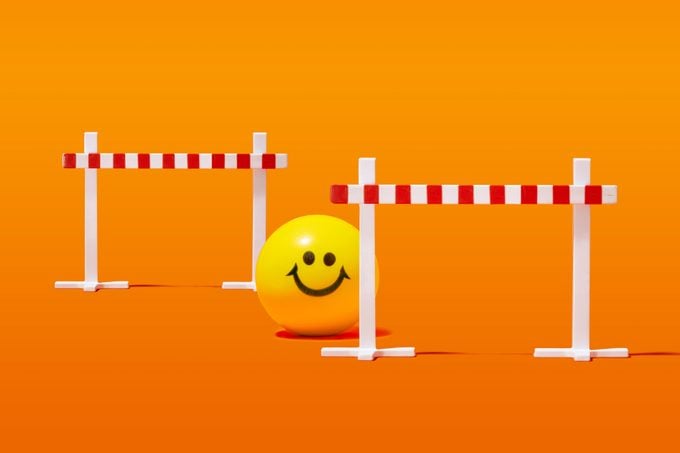How to Set Goals and Achieve Them: 7 Simple Strategies for Success
Updated: Mar. 11, 2024
Goal-setting gives meaning to our lives. Here's how to set goals—straight from the pros—and actually achieve them.

January is the go-to month for goal-setting—new year, new you and all that. But knowing how to set goals is really non-negotiable for success all year long. Goals give us something to reach for, bring greater meaning to our lives and help us learn how to be happy.
If we don’t establish goals and set boundaries, we risk spending time on aimless and countless pursuits that don’t have purpose. And we may not grow as individuals—personally or professionally. Creating a goal-setting vision board is a good first step; it can help you gain clarity about what you want to achieve in your life, why you want it and how you’re going to get it.
Beyond that, though, it’s important to firm up specific goals for your short- and long-term future. Learning how to set goals is a life skill that’ll help you as you grow and develop. To that end, let’s talk about the different types of goals, goal-setting steps and tips to help you achieve your goals.
Get Reader’s Digest’s Read Up newsletter for humor, cleaning, travel, tech and fun facts all week long.
What are goals?
A goal is usually an outcome or objective that an individual, group or organization sets out to achieve. “A goal is something to work toward or an object of one’s ambition,” says Victoria Brown, a life coach, meditation teacher and host of the Very Best Self podcast. “Many times, a goal is a vision of what we dream our fully expressed selves to be, do or have.”
There are many different types of goals too. “There are short-term goals that you can reach pretty quickly and long-term goals, which may take longer,” explains Jenna Kutcher, host of the motivational podcast The Goal Digger and author of How Are You, Really? You might aim to get your boss the report she requested by the end of the week. That’s a short-term goal. But strategizing ways to save a certain amount of money for retirement? Well, that’s long-term goal-setting.
Goals permeate all aspects of our lives. “Some goals are more about you, like personal goals for self-improvement, while others might be professional goals,” says Kutcher. “Then there are performance goals, which are about learning or doing a specific task or activity, and outcome goals, which are about the end result you want to achieve.”
Why is it important to set goals?
Goals give us something to reach for and strive to achieve. By setting goals, we give purpose to our lives. “As humans, we are not meant to stay the same—we’re meant to grow, to evolve and to change over time, but in order to do so, it’s necessary to look ahead to our future self,” says Brown. “Setting a goal is the first step to achieving a goal.”
The game of darts wouldn’t work if you threw them around arbitrarily, she explains. It takes form only once there is a defined place to start from and a clear target to hit. “Goal-setting is quite similar,” she says. “You are giving yourself a target that you are aiming to reach.”
How to set goals
Goal-setting is a way to create structure around the things you aim to achieve.
The steps to setting a goal vary depending on who you ask, explains Roger Osorio, author of the inspirational book The Journey to Reinvention and adjunct professor at the University of Pennsylvania. But if you want to learn how to set goals from the late Zig Ziglar, a motivational speaker who inspired generations, you can follow the seven steps below.
Step 1: Identify the goal
To begin, start at the end. “In this step, you set the goal, starting with the outcome, and work backward to identify process and performance,” explains Osorio.
It may sound counterintuitive to begin at the end—until you consider that a goal is an ending. So, what ending (or eventual outcome) are you aiming for? Maybe you want to lose 20 pounds by the summer. Or maybe you’re looking to save $5,000 this year.
Whatever you do, don’t go big. Goals like “be rich” or “get healthy” are setting you up for failure. “Too many people set goals that aren’t well defined or are too broad, and it makes it hard to follow through or measure their progress,” Kutcher says. She likes to think of goals in terms of the SMART acronym and framework: specific, measurable, attainable, relevant and timely.
Select SMART goals
For the best chance of achieving your goals, get smart. Using the SMART method will go a long way toward ensuring you see a goal through to the end. “By taking this first step, you are making a commitment to yourself and others that you are serious about achieving your goal,” Kutcher says.
Here’s how to set goals with the SMART method:
- Specific: Broader isn’t better. Instead of setting a goal to lose weight, set a goal to lose 20 pounds this year.
- Measurable: Make sure your goal includes a measure of success. “Get in shape” doesn’t fit the bill, but “exercise for 30 minutes, five times a week” does.
- Attainable: Don’t set yourself up for failure. Choose a goal you can actually accomplish. If you’re juggling a full-time job and solo parenting, you may not be able to do a 30-minute happiness meditation each day. A three-minute meditation may be more achievable.
- Relevant: Goals should be relevant to your life and values. Is overwork cutting into your time with family and friends—and making you generally unhappy? Then setting a goal of ending work at a certain time each night is relevant to your life.
- Timely: Without an end date, you’ll have a hard time measuring success. So when you set your goal, give yourself a deadline.
Break down large goals
Large-scale goals are a little like nesting dolls in that each contains smaller goals. Want to save a specific amount of money for retirement by the time you hit age 65? Use the SMART method to break your big goal into smaller goals you’ll need to achieve first. For instance, to save a big chunk of money for retirement, you’ll need to save a certain amount of money per year, which breaks down to a certain amount per month. From there, you can get specific about how you plan to meet your monthly savings goal. Perhaps you’ll break it down further, giving yourself weekly or even daily savings to aim for.
Keep track of your goals
Thinking about the things you want to accomplish isn’t enough. Be sure to write down your goal. “I read a statistic once that said we are 72% more likely to achieve our goals just by writing them down,” says Brown. “Goals and dreams cannot remain one dimensional in your mind. They can only take shape in our lives when they begin to exist in multiple dimensions.”
Step 2: List the benefits
Once you’ve jotted down your goal, identify—and write down!—your purpose or reason for wanting to achieve the goal, says Osorio. “The more reasons you have, the more likely you’ll persevere to the end,” he says.
Let’s say your goal is to give an hour of your time back to the community each week. What benefits of volunteering drive you to achieve this goal? Do you want to be happier, live healthier, form a community, make an impact or simply help others? Maybe all of those reasons support your goal.
Just as gratitude journaling can help you appreciate the good things in your life, writing about the reasons behind your goals can inspire you to achieve them. Knowing exercise reduces stress can drive you to hit your daily workout goal, and understanding how food boosts your mood can inspire your healthy-eating goals.
Step 3: List the obstacles

Consider everything that might get in the way of you achieving your goal, and write it down. “This is where coaches can help you troubleshoot in order to navigate your way around those obstacles,” says Osorio.
Consider the goal of doing a digital detox. What are some obstacles that might prevent you from reaching that goal? Well, you might need your computer for work. Or maybe your phone is your connection to far-flung friends.
Step 4: List the skills or knowledge required
Think about what information you’ll need or what skills you’ll have to learn or develop to achieve your goal. Then write them down.
“Brendon Burchard, a high-performance coach, is big on identifying the top skills you need in order to become the person who can achieve a particular goal,” says Osorio. “He challenges people to think strategically about which skills they focus on and, as such, hone the skills that will set them apart the most. For instance, in his case, when he got started, internet marketing was still relatively new, so he chose to focus on that because his competitors were not.”
Perhaps you have a long-term goal of working in another job sector but don’t have the training for it. You may need to go back to school, get certifications or take on an apprenticeship to gain the skills you need to accomplish the goal. Think of this as a wonderful opportunity to try new things and expand your life in a way that’ll benefit your long-term plans.
Step 5: List the people and groups you’ll need to work with
You don’t have to—and shouldn’t—feel like you must achieve your goals on your own with no help along the way. Take advantage of the community around you. “If you collaborate with others, you can create win-win opportunities to access other people’s resources,” says Osorio. “Find the people and groups who can help you move further.”
Write down those who may be able to help you make progress. Do you want to open your own business? To achieve that goal, you may want to talk to members of the local business community or other entrepreneurs who’ve run similar companies.
Step 6: Create an action plan
It’s time to write down your road map to success. This is a step-by-step list of the actions you will take in order to hit your goal. In other words, the first step may be researching to find a class if you’re looking to learn a new skill, reaching out to a mentor if your goal is career oriented or signing up for a gym membership if it’s a physical goal you have in mind.
From there, list every step you need to take to make your goal a reality.
One thing to keep in mind: There might be hurdles or roadblocks along the way. “This step is a bit controversial because, as Mike Tyson has taught us, everyone has a plan until they get punched in the face,” says Osorio. “Action plans are a great way to help you get started. However, beyond the first few steps, you have to remain flexible and adaptable to changing conditions.”
Step 7: Set the deadline
When you want to get something done, make sure there’s an exact date or time tied to its completion. Otherwise, there’s a good chance you’ll never get to it.
“A deadline will help you stay focused and give you a point by which you have to cross the finish line,” says Osorio. It’ll drive you to better time management and keep your attention from straying to other pursuits.
So what happens if you don’t reach your goal by the deadline? It’s not the end of the world. You try again. Remember, a deadline isn’t a line in the sand that determines success or failure. It’s a driving force, the thing that’ll keep your gaze on your goal.
That said, some goals may not need deadlines. “When it comes to outcome goals, if your ‘why’ is big enough, you may keep getting up after failed attempts,” Osorio says. “For example, Lionel Messi, one of the world’s greatest footballers, had to attend five World Cups in order to finally win one. I imagine his deadline was set at his first or second attempt; however, it didn’t happen. Set a deadline to keep you focused. However, be mindful that you might have to get up and try again with a new deadline.”
Tips for achieving your goals
While there are steps on how to set goals and overall practices that work for many people, it’s important to remember that goal-setting is an individual pursuit. What works for your friend or colleague may not work for you.
Get personal
“It’s easy to set goals, but if you don’t do so through the lens of who you are, what motivates you, what makes you happy, what past experience has taught you or what really matters to you, you will likely not achieve your goals,” says Kutcher. “In order to grow yourself, you have to know yourself, and so I believe that the best way to set goals is through the lens of both the goal and also who you are and what will help you stick to it.”
Take action
If you’re waiting to feel confident enough to tackle your goal, you’re just wasting time. Now’s the time to act! Brown likes to use an acronym when it comes to achieving goals: ABC, aka action builds confidence.
“We typically have it backward in thinking that we gain confidence first, then go after our lives and all that we want them to be, when really, it’s the total opposite,” she says. “We have to get ourselves into a state of ‘doing’ first. By acting, we then find confidence along the way. Go scared, go unsure, send the email, make the call, sign up for the class—whatever it is, take action, and you will notice confidence follows soon after.”
Stick to one goal
When trying to achieve a goal, it’s also important to have one main goal or focus in mind versus setting and trying to achieve multiple goals at once. “A lot of times, we set too many goals, and then we feel overwhelmed or stretched thin, and we just give up,” says Kutcher. “Having a primary project helps to focus on the efforts that will move the needle forward the most and keep efforts more focused.”
OK, but what about that major goal of saving for retirement? That’s just one goal, but it’s a doozie. So if you have a long-term goal, zero in on a single small, attainable goal that you can do in a day or week—say, putting $10 daily into savings. By making the small goal your focus, you’ll be able to eventually hit the larger one.
And while it’s important to focus on one primary goal at a time, it is OK to have multiple goals in different areas of your life. For example, you may think of a short-term work goal while you’re working on a long-term personal goal. Don’t stress if this happens, but do be aware if you start to feel overwhelmed by the number of goals you have. If that’s the case, it’s best to stick with Kutcher’s advice and decide which goal is your primary focus so you can achieve it before moving on to the next.
Track your progress
Keeping track of your progress is immensely helpful when it comes to achieving goals. “Too often, we’re so focused on the end achievement that we forget to celebrate along the way,” says Kutcher. “When I track my progress, I can see myself getting closer to the goal, which breeds more confidence and excitement in the pursuit. It keeps me accountable to doing what I set out to do and provides the insight that helps me see that I am actually closer to my end goal than I was yesterday.”
Sources:
- Victoria Brown, life coach, meditation teacher and host of the Very Best Self podcast
- Jenna Kutcher, host of The Goal Digger podcast and author of How Are You, Really?
- Roger Osorio, author of The Journey to Reinvention and adjunct professor at the University of Pennsylvania



















